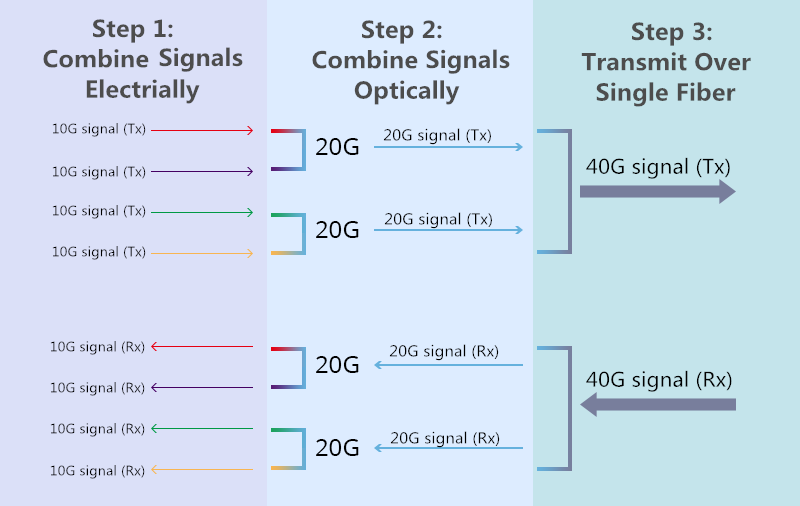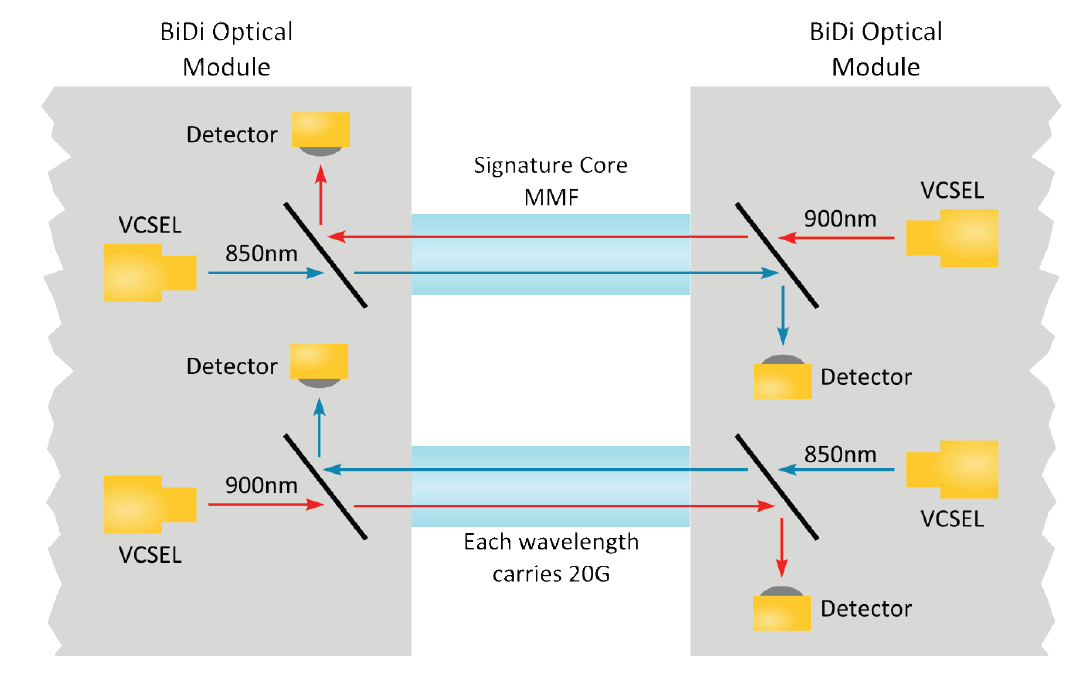In short distance data transmission, 40GBASE-SR4 and 40GBASE-CSR4 fiber optic transceivers are usually used for the 40G network. Unlike the traditional 10G network connections, the 40G connections require 12-fiber MTP/MPO connectors and 12 fibers to accomplish the transmission. However, cable routing is definitely a big challenge for the migration from 10G to 40G network over short distance. If the transmission of 40G over duplex multimode fiber optic cable is feasible, we don’t have to change the cabling infrastructure which greatly saves our time and money.
Realizing 40G Over Duplex MMF By 40GBASE-SR BiDi QSFP
Is it possible to transmission 40G over duplex multimode fiber optic cables? With 40GBASE-SR BiDi QSFP transceivers, the answer is yes. The following will introduce the details of this optics. Compare with the traditional 40G QSFP+ transceivers like 40GBASE-SR4 and 40GBASE-CSR4, 40GBASE-SR BiDi QSFP optics use a much more straightforward transmission mode.
The traditional 40G QSFP+ transceivers like 40GBASE-SR4 and 40GBASE-CSR4 use 4*10G transmission mode occupying 4 fibers for sending and 4 fibers for receiving as shown in the following picture. Usually a 12-fiber MPO connector is used with 4 fibers unused.

For 40GBASE-SR BiDi QSFP optics only a duplex LC patch cord can finish 40G transmission over MMF and can perfectly achieve the migration from 10G to 40G. 40GBASE-SR BiDi QSFP take advantages of fiber optic multiplexing.
Operations of 40GBASE-SR BiDi QSFP
There are mainly three steps for 4*10G signals transmitting via 40GBASE-SR BiDi QSFP module. The first step is electrical. The four 10G signals are electrically combined together into 20G and 20G. The second step is an optical combining using two different wavelengths going on the same fiber strand. In the third step, the two 20G signals are sent to the other 40GBASE-SR BiDi QSFP module on the target device via the single optical fiber. The 40G signals are receiveds from the other 40GBASE-SR BiDi QSFP module on the other end of the optical fiber. The process for receiving is reverse. This is how a pair of BiDi QSFP transmit 40G signals over a duplex fiber optic patch cable. The following picture shows the basic working principle of this 40G BiDi QSFP module.

The most commonly used two wavelengths for 40G BiDi QSFP module are 850 nm and 900 nm. The two wavelengths support reliable transmission over multimode fiber optic cables up to 150 meters over OM4 and 100 meters over OM3, which can perfectly fit the 40G short distance transmission in data center. To help you better understand this module. The following picture shows the internal structure of the 40G BiDi QSFP module and how a pair of BiDi QSFP modules working with each other.

High Density Cabling Solution for 40GBASE-SR BiDi QSFP Modules
With 40GBASE-SR BiDi QSFP module, cabling in data center or server room would be much easier. As above mentioned, you do not have to change your cabling infrastructure for 40G BiDi QSFP. A pair of duplex LC-LC multimode fiber optic patch cable is enough. OM3 and OM4 are suggested. For high density cabling, a new version of LC patch cord—LC-HD duplex multimode fiber optic cable is suggested. This type of patch cable has a tab attached on the connector, which offers easier finger reach for telecom engineers. With 40GBASE-SR BiDi QSFP modules, you can scale your 40G network easily and cost-effectively.
Conclusion
As for 40G short range data propagation, the application of 40GBASE-SR BiDi QSFP transceiver is a good solution that reduces the difficulty of cable routing. With an easier connection, it is much more time-saving and cost-effective to adopt this type of transceiver in your network. Why not give it a try?
没有评论:
发表评论